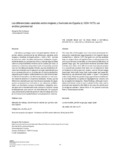Mostrar o rexistro simple do ítem
Los diferenciales salariales entre mujeres y hombres en España (c.1850-1975): un análisis provisional
| dc.contributor.author | Vilar Rodríguez, Margarita | |
| dc.date.accessioned | 2020-03-23T12:07:13Z | |
| dc.date.available | 2020-03-23T12:07:13Z | |
| dc.date.issued | 2014 | |
| dc.identifier.citation | Vilar-Rodríguez, M. (2014). Los diferenciales salariales entre mujeres y hombres en España (c.1850-1975): un análisis provisional. Áreas. Revista Internacional De Ciencias Sociales, (33), 63-85. Recuperado a partir de https://revistas.um.es/areas/article/view/216051 | es_ES |
| dc.identifier.issn | 1989-6190 | |
| dc.identifier.uri | http://hdl.handle.net/2183/25213 | |
| dc.description.abstract | [Resumen:]Este artículo persigue como principal objetivo ofrecer un primer análisis provisional de las diferencias salariales entre mujeres y hombres en España entre c. 1850 y 1975. Se trata de poner en orden los datos disponibles, analizarlos conjuntamente desde una perspectiva crítica y avanzar algunas ideas sobre el comportamiento histórico de los salarios por sexo. La evidencia cuantitativa disponible hasta el momento permite concluir tres ideas principales. Primera, que las estadísticas oficiales han colocado a las mujeres en un lugar subordinado que no se corresponde con su contribución al sistema productivo. Segunda, que el salario medio femenino ha sido históricamente inferior al masculino y las diferencias salariales se mantuvieron bastante estables en el periodo analizado. Tercera, que las diferencias salariales por sexo han ido acompañadas de segregación ocupacional por industrias y por categorías profesionales. Los resultados, aunque incompletos y sesgados, servirán para abrir el debate sobre esta cuestión e impulsar nuevas investigaciones que avancen en esta dirección. En cualquier caso, este artículo pretende poner en valor el trabajo de la mujer en la economía española desde una perspectiva histórica. [Abstract:]The main aim of this paper is to show some provisional evidences for male-female wage disparity in the Spanish labour market from c. 1850 to 1975. The goal is to sort the available data, to analyse them all together from a critical perspective and to put forward some ideas on the historical behaviour of gender wage gap. The quantitative evidence provided leads to three main ideas. First, official records have placed women in a subordinate position that does not correspond to their contribution to the production system. Second, female wages have been historically lower than male wages and wage differentials by sex remained fairly stable in Spain in the period under study. Third, the gender wage gap has been traditionally accompanied by occupational segregation by industry and by occupational categories. These findings, although incompletes and biased, serve to start a debate on this topic, and to promote new research in this field. In any case, this article aims to recognise women´s labour force in the Spanish economy from a historical perspective | es_ES |
| dc.language.iso | spa | es_ES |
| dc.publisher | Universidad de Murcia | es_ES |
| dc.relation.uri | https://revistas.um.es/areas/article/view/216051 | es_ES |
| dc.rights | Atribución-NoComercial-SinDerivadas 3.0 España | es_ES |
| dc.rights.uri | http://creativecommons.org/licenses/by-nc-nd/3.0/es/ | * |
| dc.subject | Mercado de trabajo | es_ES |
| dc.subject | Discriminación salarial | es_ES |
| dc.subject | Discriminación salarial por género | es_ES |
| dc.subject | Salario | es_ES |
| dc.subject | España | es_ES |
| dc.subject | Trabajo de la mujer | es_ES |
| dc.subject | Labour market | es_ES |
| dc.subject | Spain | es_ES |
| dc.subject | Gender wage gap | es_ES |
| dc.subject | Wage | es_ES |
| dc.subject | Spain | es_ES |
| dc.title | Los diferenciales salariales entre mujeres y hombres en España (c.1850-1975): un análisis provisional | es_ES |
| dc.title.alternative | The gender wage gap in Spain from a historical perspective (c. 1850-1975): a provisional analysis | es_ES |
| dc.type | info:eu-repo/semantics/article | es_ES |
| dc.rights.access | info:eu-repo/semantics/openAccess | es_ES |
| UDC.journalTitle | Áreas: Revista Internacional De Ciencias Sociales | es_ES |
| UDC.issue | 33 | es_ES |
| UDC.startPage | 63 | es_ES |
| UDC.endPage | 85 | es_ES |
Ficheiros no ítem
Este ítem aparece na(s) seguinte(s) colección(s)
-
GI-GEHE - Artigos [125]






